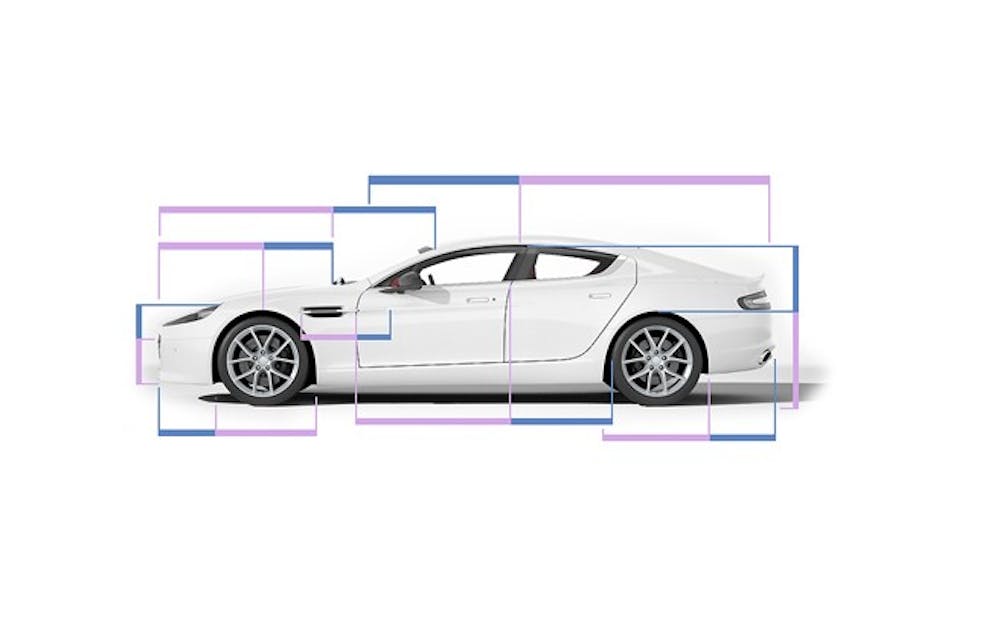Aston Martin’s Rapide S sports car is the latest design to make use of the ancient golden ratio, which mechanical engineering professor Adrian Bejan said confers a natural sense of beauty and speed.
The golden ratio is the relationship of the length of an object to its width or height that approximately equals 3/2, resembling the shape of a rectangle. Rapide S, the newest in Aston Martin’s line of sports cars, boasts an external design that adheres to the golden ratio in nearly every aspect. Bejan uses his theory of the constructal law to explain the ratio’s mysterious but enduring aesthetic appeal.
The constructal law, which defines the world as a teeming environment of flow systems, theorizes that humans select for shapes and objects that optimize our ability to travel across a landscape.
“We like this shape, and the reason is because our mind grasps this image the fastest when scanning a field of vision, which is the same shape as this rectangle,” Bejan said. “We equate this shape with speed and [therefore] movement, something that human evolution prefers.”
According to the Rapide S’s official website, the golden ratio sits at the heart of every Aston Martin. For the Rapide S, the designers have gone to the extreme, using the ratio to define the form of the entire car.
The actual golden ratio, first defined by the Greek mathematician Euclid to have a value of about 1.618, is a myth, Bejan said. To him, the phenomenon of the golden ratio is not its value like pi, which is observable in nature and quantitatively important.
“The true phenomenon is that all of us, without talking to each other, tend to be attracted to the ratio like insects to light,” he said.
A large part of this attraction may be attributed to the speed at which we can visually process an object, Bejan added. The optimal efficiency occurs when the time taken to scan horizontally equals the time it takes to scan vertically. Since we have two front facing eyes, we naturally scan horizontally at a faster rate than we do vertically, because one eye can take over for the other after a certain point of rotation.
In vertical scanning, both eyes must do the same task. Therefore, given a certain amount of time, we can horizontally process more of an image than we can vertically, naturally resulting in a rectangular shape.
“To see an image and process it in the brain faster is to move faster,” Bejan said. “Vision is synonymous with locomotion in the animal realm. That is why the [Rapide S], with that shape, looks fast.”
From an evolutionary perspective, Bejan believes that humans continuously strive for movement, a quality of our species reflected in our appreciation of the golden ratio. Something that can move us quickly increases our accessibility to opportunities. Bejan argues that the biological species that defines us is not simply man—it is man and machine. Machines are how the modern man moves and so the vehicle that can transport us the quickest is the most attractive.
“This is how and why we move,” Bejan said. “We are a human-machine species because our physical bodies alone do not represent us—man and vehicle together is a biological species.”
Although constructal law offers one explanation, we do not know for sure why the golden ratio is aesthetically pleasing.
Still, designers in many fields apply this principal to their work. For example, aside from vehicle designers, architects use the golden ratio as well. Simon Unwin, emeritus professor of architecture at the University of Dundee, Scotland, said instances of the golden ratio can be found anywhere from Leonardo da Vinci’s “Vitruvian Man” to recent Royal Institute of British Architects Gold Medal winner Peter Zumthor’s design of his Thermal Baths. Unwin believes that aside from its visual appeal, the golden ratio is also a very convenient tool to have.
“Designing is a difficult thing [and] making decisions about relative sizes is [hard]” Unwin wrote in an email Sunday. “If you adopt a rule—such as using the golden ratio whenever you can—life becomes easier. The decision is made for you by the rule you have adopted.”
Aston Martin’s use of the golden ratio, however, may be more of an advertising ploy than a credible evaluation of the design, Unwin noted.
“If you analyze the actual application of the golden ratio in the design (as indicated on the photograph on their website), the instances where it is used are somewhat arbitrary,” Unwin said. “The suspicion is that they are playing an advertising game. Would that be a new thing? Of course not!”
Get The Chronicle straight to your inbox
Sign up for our weekly newsletter. Cancel at any time.

